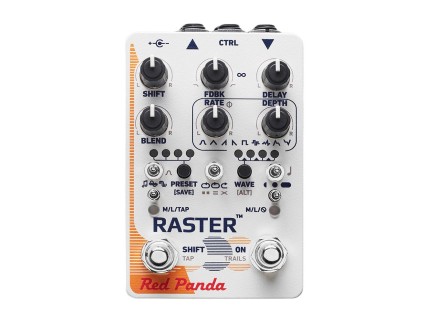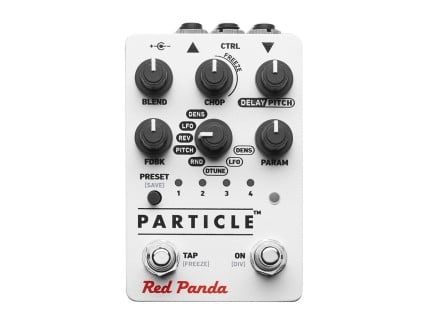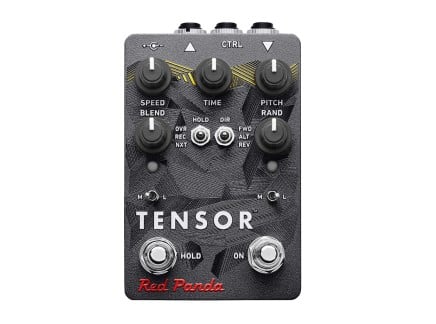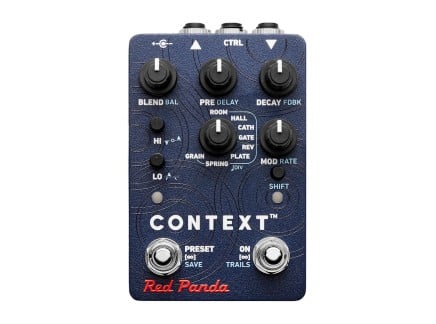Widely used for both guitar pedalboards and fantasy sound design, pitch-shifting delays are a brilliant source for adding magic and interplaying harmony to your effect collection. They have a stellar and unique history of adding pitch variance to your instrument or sound, rising and falling over time and throughout the stereo field with intriguing feedback configurations. The Publison DHM 89 B2 and Eventide Harmonizer H949, for instance, accomplished many groundbreaking feats in the rackmount realm with independent stereo pitch-shifting and delay times, micro/detuning, and external pitch control via a keyboard. Eventually, the beloved Boss PS-3 and Digitech XP-300 Space Station brought many of these features to the guitar pedal ecosystem with the fantastic incorporation of everything from reverse pitch-shifts to lush, reverberant shifted spaces and more.
This multi-faceted and wildly sought after effect was originally introduced in a new flavor from Red Panda as the Raster in 2015, including not only independent and combinable digital pitch-shifting and delay, but also even phase shifting delays—this effect produces swirly effects that go great with a variety of uses! Multiple feedback modes let you switch how the delay interacts with the pitch shifter, making for interesting forward feed and reverse audio pitch-shifting for shimmer-like delays and otherworldly tonal characteristics. However, in 2021, we were blessed by a new iteration that boasts configurable modulation, adjustable routing, expanded footswitch functionality, and stereo I/O with tons of configurations for how each parameter works in the stereo field. Let's dive into why Raster 2 is a brilliant evolution in pitch-shifting delays with unique functionality that makes it just as good a pedalboard effect as much as a studio effect.
Spatialized, Modulated, and Redesigned
Raster 2 picks up beautifully where its predecessor left off, divided into two independent sections that can intertwine to produce brilliant results: Delay and Shift. The Delay section features a traditional delay time and feedback controls, with the delay time offering set time configurations of 400ms, 800ms, and 1600ms ranges via a three way switch—you can even achieve up to 3200ms when using Red Panda's web editor or MIDI CC. The Shift functionality features three flavors to make intervallic or inharmonious tones to complement your input, including a Transpose mode to achieve quantized pitch shifts, a Detune mode for continuous and even micro pitch adjustments, and a Phase/Frequency Shift mode that can achieve bubbly phase shifting as well as dissonant intervals thanks to the newly added frequency shifter. These two in combination produce a wealth of effects, with routing options to run the feedback through Shift, include Shift in the feedback, or even reverse the delay with Shift included in the feedback loop for time-mangling goodness.
The response of the delay time is so unique to a digital delay, characterized by gentle and careful shifts when moved gently or spun out and chasing delay times when moved swiftly. The delay section's footswitch is quite programmable: it can work as momentary, latch, or can even mute the output while the input still processes, and customizing whether the delay trails when in bypass is a nice touch for delay throws or singular processed moments that ring out. Similar on the Shift side, the footswitch can be momentary or latching—or it can be used as a tap tempo for the delay time if you're in a pinch for synchronization. With this degree of customization over how each footswitch acts, you can create complex and performable effects that can work independently or in tandem depending on your routing and use. You can even further add interest with the modulation section, complete with control over rate and depth as well as seven LFO shapes and two flavors of envelope following. With routing capabilities to the delay time, shift control, or effect level, you can achieve chorusing, vibrato, tremolo, and so much more.
What really brings Raster 2 into its own is not only the stereo I/O (achievable with 1/4" TRS cables and splitters), but also the profound number of ways to achieve stereo imaging. Starting simply, the delay configuration can be set up to run series for a mono style effect still utilizing both delay lines and shifters, or you can utilize it in parallel for independent stereo pitch shifts or even ping-pong for cross-feedback fun. Access any secondary parameter in grey by holding the Wave [Alt] button until the Delay light turns cyan—from here, you can apply stereo offsets to any of the top parameters as well as access routing capabilities for modulation, stereo routing, and even tap tempo related time divisions on the delay. Offsetting the Delay control in either direction creates delay time ratios between the left and right channel, while offsetting the Blend control will tilt the balance of the effect signal in either direction. Shift's alternative left/right balance is unique for each mode, giving you options for octaves and chords, inverted detune, and even opposing frequency shifts. Additionally, you can offset how strongly the modulation affects each side as well as apply an offset of up to 180 degree out-of-phase to the LFO on either side, great for chorusing, phasing, and so many other uses.
You can add some final balance to your entire sound with the Blend control to mix between the dry and wet signal as well as the Alt tone control, providing cuts toward either the highs or the lows. Once happy, all these settings can be saved to one of the four available presets on board for easy access, but if that isn't sufficient enough, you can save and access up to 127 presets over MIDI. Additionally, the control port jack allows parameter control via MIDI or expression pedal, and even allows for remote switching and remote tapping. For easier editing and preset access, there is a mini USB jack for connecting to the web-based editor—also great for connecting external MIDI control. Implementing MIDI with your Raster 2 is a great way to make sure your pedal is synced to your other gear, as well as bringing automation to the table for an even more performative experience.
You can see Raster 2 in full action in the video above, with Jacob demonstrating how well it responds to a wide range of notes from his eight-string, achieving lush chorusing delays, ethereal arpeggios, and blissful chirps that are all indicative of a wonderful pitch-shifting delay. Of course, rising pads and lines are only one side of pitch-shifting, while descending harmonies and pitches can burgeon ghoulish and melancholic tones for a bit of the darker side of ambience and sound design. Pitch-shifting delays entrance the listener and expand your sounds in numerous sonic directions, and Red Panda's Raster 2 does this in such a flexible way that is unparalleled in its format and price range. I take awe in its magnificence, but I implore you to try it out for yourself!











